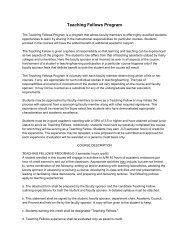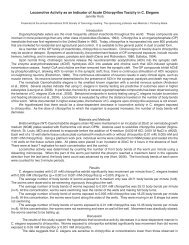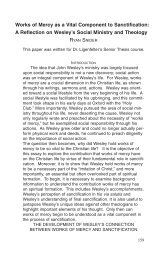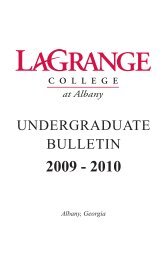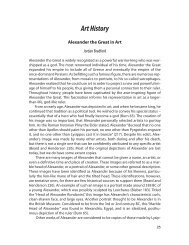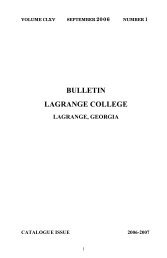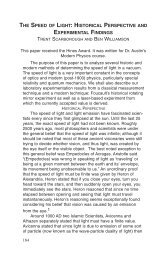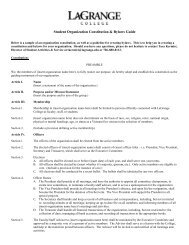Giovanni Arnolfini and His Bride
Giovanni Arnolfini and His Bride
Giovanni Arnolfini and His Bride
You also want an ePaper? Increase the reach of your titles
YUMPU automatically turns print PDFs into web optimized ePapers that Google loves.
GIOVANNI ARNOLFINI AND HIS BRIDE:<br />
AHOPED-FOR PREGNANCY<br />
FLEMMING GARNER<br />
This paper was written for Dr. Joiner’s Renaissance Art <strong>His</strong>tory course.<br />
Jan van Eyck, <strong>Giovanni</strong> <strong>Arnolfini</strong> <strong>and</strong> <strong>His</strong> <strong>Bride</strong>, 1435.<br />
Jan van Eyck’s celebrated painting, <strong>Giovanni</strong> <strong>Arnolfini</strong> <strong>and</strong><br />
<strong>His</strong> <strong>Bride</strong>, has been given many titles over the years: The<br />
<strong>Arnolfini</strong> Portrait, The <strong>Arnolfini</strong> Wedding Portrait, <strong>and</strong> The<br />
<strong>Arnolfini</strong> Double Portrait are the most common of these. And<br />
along with the painting’s many titles has come a plethora of<br />
analyses <strong>and</strong> interpretations. Erwin Panofsky was among the<br />
first, giving what is now known as the classical analysis of the<br />
painting. Panofsky suggested meaning for images within the<br />
work, such as the signature of the artist, representing his witnessing<br />
of a marriage, making the painting in his words a “pictorial<br />
marriage certificate” (124). After Panofsky’s 1934 commentary,<br />
the painting again came under scrutiny in 1989 by the feminist<br />
critic Linda Seidel. According to Seidel, <strong>Giovanni</strong> <strong>Arnolfini</strong><br />
appeared to “have been marrying ‘up’” (60), alleging that in fact<br />
23
<strong>Giovanni</strong> <strong>Arnolfini</strong> <strong>and</strong> <strong>His</strong> <strong>Bride</strong>: A Hoped-For Pregnancy<br />
Giovanna <strong>Arnolfini</strong> had the money in the marriage. Each critic<br />
of The <strong>Arnolfini</strong> Portrait has given a new twist to the painting<br />
<strong>and</strong> to the meaning behind the two central figures. The varying<br />
interpretations notwithst<strong>and</strong>ing, the work has a fundamental<br />
focus in the painting on fertility <strong>and</strong> childbearing. This focus is<br />
clear in the numerous veiled symbols <strong>and</strong> in the painter’s allusion<br />
to a traditional Annunciation scene.<br />
The two figures in the painting have been firmly identified:<br />
<strong>Giovanni</strong> <strong>Arnolfini</strong>, a Lucchese cloth merchant, <strong>and</strong> Giovanna<br />
Cenami, the daughter of a fellow cloth merchant, also from<br />
Lucca in Italy. Theirs was a powerful political union of two influential<br />
Italian families living in Northern Europe. As <strong>Arnolfini</strong> continued<br />
with his career <strong>and</strong> became very wealthy, he began to<br />
work for the Medici Bank <strong>and</strong> then found himself immersed in<br />
the politics of Northern Europe. The hope of this union was to<br />
produce an heir who would continue in the cloth business, especially<br />
since <strong>Giovanni</strong> <strong>Arnolfini</strong> was often away for political reasons.<br />
During the 15 th century, moreover, women had specific<br />
responsibilities within the home, childbirth being the most important<br />
of these duties. The <strong>Arnolfini</strong> betrothal is one of many portraits<br />
created with the similar idea of presenting a newly-wed<br />
couple <strong>and</strong> then underscoring the hoped-for procreation.<br />
In the case of <strong>Arnolfini</strong> <strong>and</strong> his young bride, van Eyck has<br />
featured several veiled indications alluding to the prospect of<br />
fertility <strong>and</strong> conception. The 15 th century Northern community<br />
had high expectations for married women, especially for recently<br />
married brides, to conceive, preferably on the first night of the<br />
marriage. Because of the emphasis placed on the importance<br />
of having children <strong>and</strong> of forming a family, Northern women<br />
often surrounded themselves with tokens to induce fertility in<br />
hope for a successful pregnancy. Thus, Giovanna Cenami<br />
st<strong>and</strong>s on the right of the portrait by a beautiful red bed, which<br />
not only displays her status in the home but also her wifely duty<br />
of producing children. As a follower of the customs regarding<br />
childbearing, Cenami st<strong>and</strong>s barefoot beside the bed, her red<br />
slippers under a bench in the distance. As Craig Harbison<br />
observes, “The bare foot or accompanying shoe is an almost<br />
universal symbol of fecundity, [<strong>and</strong>] women especially must<br />
touch the earth to be fertile” (261). It was later that during the<br />
17 th century that artists displayed the removal of slippers as evidence<br />
of sexual passion. According to Harbison, “Northern<br />
24
Flemming Garner<br />
manuscripts <strong>and</strong> panels can also be seen reflecting these<br />
ancient customs” (261).<br />
It is particularly in the painting’s fruits that van Eyck symbolizes<br />
fertility. Just outside the window is a tree crowded with<br />
cherries, noted by Chevalier <strong>and</strong> Gheerbrant as “expressions of<br />
sexual desire” (412). And below on the chest sit oranges that<br />
Harbison considers directly “connected in numerous ways to<br />
marital <strong>and</strong> fertility rituals; especially when the newly-wed couple<br />
returns home to consummate their marriage, they are offered<br />
fruit <strong>and</strong> sweetmeats” (261-262). Fruit was also offered as a<br />
“cure to the morning sickness of pregnancy” (Harbison, 286).<br />
This image in particular shows the eagerness of the couple to<br />
have children, for the oranges are already there in anticipation<br />
of a successful impregnation. And “the fruit in Van Eyck’s work<br />
is no doubt meant to evoke fruitfulness . . .” (Harbison, 263).<br />
Yet another symbol refers to childbearing. Just above the couple’s<br />
h<strong>and</strong>s is a tiny statue of a monster, an attribute of Saint<br />
Margaret of Antioch. Margaret was a beautiful girl who declared<br />
her Christian faith to an admirer who took offense <strong>and</strong> locked<br />
her up in prison. It was while imprisoned that Margaret was tortured<br />
by the Devil in the form of a dragon; it is for this reason<br />
that Saint Margaret has the attribute of a monster. Margaret<br />
Carroll states that the little statue in van Eyck’s painting is a further<br />
attempt to ensure a successful conception, St. Margaret<br />
serving the couple as guardian to the fruitfulness of the womb<br />
<strong>and</strong> as the “patroness of childbirth” (107).<br />
A further reference to pregnancy can be seen in the stance<br />
of the pair. <strong>Arnolfini</strong> <strong>and</strong> his wife have been compared to a traditional<br />
Annunciation scene. This interpretation hinges upon the<br />
gesture of <strong>Arnolfini</strong>’s right h<strong>and</strong>. Harbison has observed that<br />
this gesture was “originally more rigid <strong>and</strong> upright, more oathlike<br />
in fact” (263). X-Ray analysis has revealed that the artist<br />
altered <strong>Arnolfini</strong>’s right h<strong>and</strong> to be more of a greeting than in<br />
earlier versions. This emendation shows that the husb<strong>and</strong> takes<br />
the place of the Angel Gabriel <strong>and</strong> his wife is then likened to the<br />
Virgin Mary, who will hopefully give birth to his child. In the<br />
words of Harbison, “It would seem an appropriate gesture during<br />
an Annunciation, acknowledging the “desired conception <strong>and</strong><br />
eventual birth of a child” (263). To underscore this interpretation,<br />
Harbison sees the presence of the Lord indicated in the<br />
“discarded slippers [on the left] <strong>and</strong> burning c<strong>and</strong>le, show[ing]<br />
the Trinity [<strong>and</strong>] answering a couple’s plea by sending down<br />
25
<strong>Giovanni</strong> <strong>Arnolfini</strong> <strong>and</strong> <strong>His</strong> <strong>Bride</strong>: A Hoped-For Pregnancy<br />
child from heaven” (267). The discarded slippers in this context<br />
represent the couple st<strong>and</strong>ing on holy ground, while the burning<br />
c<strong>and</strong>le reveals the Holy Ghost within the Trinity. A final presage<br />
of childbearing is seen in the fact that Giovanna <strong>Arnolfini</strong> lifts her<br />
green dress toward her waist, creating a protuberance akin to<br />
that of a pregnant woman. Edwin Hall writes that by “lifting her<br />
voluminous green gown [Giovanna is] thus quietly receptive to<br />
[her husb<strong>and</strong>’s] advances” (xix).<br />
These symbols—the fruit, the statuette of a monster, <strong>and</strong> the<br />
discarded slippers—together with the allusion to an<br />
Annunciation scene, underscore the <strong>Arnolfini</strong>s’ desire for a child.<br />
This interpretation strengthens the work Jan van Eyck created,<br />
because although <strong>Giovanni</strong> <strong>and</strong> Giovanna <strong>Arnolfini</strong> never conceived<br />
a child of their own; they nevertheless hope for one.<br />
This exact emotion apparent within the painting Jan van Eyck is<br />
able to capture; for the foundation of <strong>Giovanni</strong> <strong>Arnolfini</strong> <strong>and</strong> <strong>His</strong><br />
<strong>Bride</strong> is the couple’s assurance of a hoped-for pregnancy.<br />
26
Flemming Garner<br />
WORKS CITED<br />
Carroll, Margaret D. “‘In the Name of God <strong>and</strong> Profit’: Jan<br />
van Eyck’s <strong>Arnolfini</strong> Portrait.” Representations, 44<br />
(autumn 1993) 96-132. 26 Nov. 2007<br />
.<br />
Chevalier, Jean, <strong>and</strong> Alain Gheerbrant. Trans. John<br />
Buchanan-Brown. The Penguin Dictionary of Symbols.<br />
London: Penguin Books, 1996.<br />
Hall, Edwin. The <strong>Arnolfini</strong> Betrothal: Medieval Marriage <strong>and</strong><br />
the Enigma of van Eyck’s Double Portrait. Berkeley <strong>and</strong><br />
Los Angeles: University of California Press, 1994.<br />
Harbison, Craig. “Sexuality <strong>and</strong> Social St<strong>and</strong>ing in Jan van<br />
Eyck’s <strong>Arnolfini</strong> Portrait.” Renaissance Quarterly<br />
43.2(summer 1990), pp249-291. 26 Nov. 2007<br />
.<br />
Panofsky, Erwin. “Jan van Eyck’s <strong>Arnolfini</strong> Portrait.” The<br />
Burlington Magazine for Connisseures 64.372 (March<br />
1934) pp. 117-119+122-127. 24 Feb. 2008<br />
.<br />
Seidel, Linda. “Jan van Eyck’s <strong>Arnolfini</strong> Portrait: Business as<br />
Usual?” Critical Inquiry 16.1(autumn 1989) pp. 54-86. 24<br />
Feb 2008 .<br />
27




